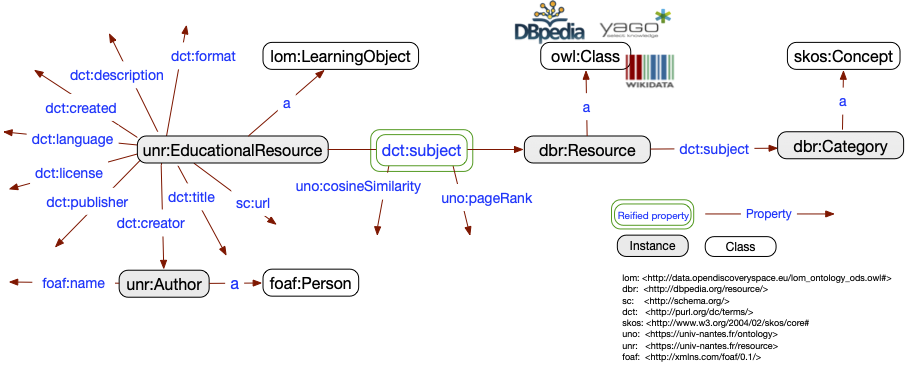CLARA Knowledge Graph
Figure 1 depicts the CLARA ontology diagram. Consistent with the ODS recommendation, we define Educational Resources (ER) as LOM (Learning Object Metadata) Learning Objects. The LOM standard suggests a range of properties to describe learning objects, using common vocabularies such as Dublin Core and FOAF (dct:title, dct:creator, dct:language, dct:licence, dct:format, foaf:name, etc).
The particularity of our ontology lies in the extension of the LOM description to consider the subjects treated in the learning objects with relevance scores. To do this, we use RDF statement-level reification. Reification allows making statements about statements in a generic manner. In our case, it will allow to state that an ER treats a particular subject to some extent. Concretely, it will allow to annotate the predicate dct:subject in a fact (unr:EducationalResource, dct:subject, dbr:Resource) with relevance scores. In our project, these scores are determined using a wikification process, which identifies pagerank and cosine similarity values.
The CLARA knowledge graph is openly accessible with the CC BY licence in this SPARQL endpoint https://clara.univ-nantes.fr/sparql
CLARA Pipeline
Figure 2 shows the pipeline for the CLARA ETL process. The extraction phase involves collecting data from a Postgres database. In the transformation phase, JSON files are converted into semantic RDF triples. To compare different RDF reification models, we created four RML mappings to obtain standard reification, RML-star, named graphs, and singleton properties. We used SHACL shapes to validate our RDF graphs. In the loading phase, we loaded and set up two SPARQL endpoints: Virtuoso and Jena. The rest of this section focus on the RML mappings that are available on GitLab (https://gitlab.univ-nantes.fr/clara/pipeline)
CLARA Search Engine
We have developed a first version of a search engine that, based on keywords, returns the most relevant ERs. Results are ordered by relevance. It provides a knowledge graph visualisation of relevant ERs and relevant related concepts. In addition, it shows a licence compatibility graph of bookmarked ERs.
The CLARA search engine is accessible at https://clara.univ-nantes.fr. Next video shows a demonstration of this search engine.



